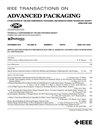Lead-Free Solder Material and Chip Thickness Impact on Board-Level Reliability for Low-K WLCSP
引用次数: 10
Abstract
This paper evaluates the effect of the solder ball material and chip thickness on board-level reliability using low-K wafer-level chip-scale packaging (WLCSP). The composition of the three evaluated solder ball materials includes SnAg1.0Cu0.5, SnAg2.0Cu0.5, and SnAg2.6Cu0.6. The chip thickness is ranging from 200, 300, and 775 ¿m. Initially, the high temperature storage and ten-time multiple reflow tests were used as the wafer-level reliability test items. The work uses both the low speed (500 ¿m/s) and the high speed (200 mm/s and 1 m/s) solder ball shear test to compare the shear force, displacement, and fracture energy of the three solder compositions. The high speed shear test result shows the high silver content correlates to small displacement and the low fracture energy. Next, the finite element model was employed to compare the board level chip and solder ball stress for these three different chip thicknesses. The finite element method simulation results indicate the thinner chip implies the preferred thermal fatigue cycles. In addition, the drop test results show the chip thickness of 200 and 300 ¿m improve the drop test performance (81 drops and 88 drops) by 20.9%-31.34% than that of chip thickness of 775 ¿m. Moreover, the chip thickness of 200 and 300 ¿m substantially enhance the thermal fatigue life (665 cycles and 655 cycles) by 81.44%-84.21% than that of chip thickness of 775 ¿m using the SnAg1.0 Cu0.5. Notably, the experimental results correlate well with the simulation trend. This work provides a design guideline for selecting the favorable solder materials and the chip thickness to obtain the satisfactory board-level reliability of the low-K WLCSP packaging.无铅焊料和芯片厚度对低k WLCSP板级可靠性的影响
本文采用低k晶圆级芯片级封装(WLCSP),评估了焊球材料和芯片厚度对板级可靠性的影响。所评估的三种焊料球材料的组成包括SnAg1.0Cu0.5, SnAg2.0Cu0.5和SnAg2.6Cu0.6。切屑厚度从200、300和775¿m不等。初步采用高温贮存试验和十次多次回流试验作为片级可靠性试验项目。本工作采用低速(500¿m/s)和高速(200 mm/s和1 m/s)焊锡球剪切试验,比较三种焊锡成分的剪切力、位移和断裂能。高速剪切试验结果表明,高银含量与小位移和低断裂能相关。其次,采用有限元模型比较了三种不同芯片厚度下的板级芯片和焊球应力。有限元模拟结果表明,薄片越薄,热疲劳循环周期越优。此外,跌落试验结果表明,200和300¿m的切屑厚度比775¿m的切屑厚度提高了跌落试验性能(81滴和88滴)20.9% ~ 31.34%。此外,在SnAg1.0 Cu0.5中,200和300¿m的切屑厚度比775¿m的切屑厚度显著提高了热疲劳寿命(665次和655次),提高了81.44% ~ 84.21%。值得注意的是,实验结果与模拟趋势吻合良好。为低k WLCSP封装获得满意的板级可靠性,选择合适的焊料材料和芯片厚度提供了设计指导。
本文章由计算机程序翻译,如有差异,请以英文原文为准。
求助全文
约1分钟内获得全文
求助全文

 求助内容:
求助内容: 应助结果提醒方式:
应助结果提醒方式:


